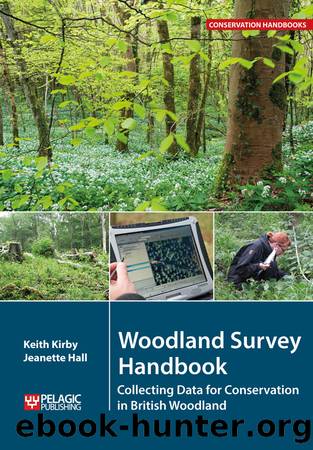Woodland Survey Handbook by Kirby Keith; Hall Jeanette;

Author:Kirby, Keith; Hall, Jeanette;
Language: eng
Format: epub
Publisher: Pelagic Publishing
Figure 7.2 Abundance of five breeding bird species in relation to age of coppice growth (years after cutting) in Bradfield Woods, Suffolk, in 1987 (based on surveys described in Fuller and Rothery 2013). The data were gathered using territory mapping across 64 ha. Ten morning visits were made, mainly in April and May. Where a territory spanned more than one compartment, it was allocated proportionately according to the number of registrations in each.
Point counts are now more commonly used in surveys where the aim is to make comparisons of the relative abundance of bird species in a series of woods or study areas, or for comparisons over time (Hewson et al. 2007). A series of random or systematic points are chosen in each study area, at least 100 m apart to reduce the chance of counting the same birds at different recording stations. At each point, the observer records the birds seen or heard in a fixed period; these may be split into ‘near’, for example within 25 m of the recorder, and ‘far’ (more than 25 m from the recorder) records, or even recorded in multiple distance bands. At least two visits should be made, for example in mid-April to early May and again in mid-May to early June, to allow for seasonal variation in breeding activity and detectability. Habitat measurements, such as of the vegetation structure (see Sections 5.5 and 6.3), may be made at the same time.
Spatial and temporal context can be found in the atlases of bird distribution (Balmer et al. 2013) (https://www.bto.org/volunteer-surveys/birdatlas), with some woodland specialists in particular showing recent declines (https://www.bto.org/about-birds/birdtrends/2014). The main programme for long-term monitoring of birds is the Breeding Bird Survey (https://www.bto.org/volunteer-surveys/bbs), and a composite index of woodland bird population trends forms part of the Defra biodiversity indicators (http://jncc.defra.gov.uk/page-4235). There are periodic surveys for individual species, such as for nightingales (https://www.bto.org/volunteer-surveys/nightingale-survey), woodcock (https://www.bto.org/volunteer-surveys/woodcock-survey/results) and capercaillie (Ewing et al. 2012). Perhaps the most studied woodland bird populations, using a variety of different techniques, are blue and great tits in Wytham Woods, Oxfordshire (http://wythamtits.com/#intro).
Other guidance on bird survey methods can be found at https://www.cieem.net/birds and https://www.bto.org/volunteer-surveys.
Download
This site does not store any files on its server. We only index and link to content provided by other sites. Please contact the content providers to delete copyright contents if any and email us, we'll remove relevant links or contents immediately.
| Automotive | Engineering |
| Transportation |
Whiskies Galore by Ian Buxton(41529)
Introduction to Aircraft Design (Cambridge Aerospace Series) by John P. Fielding(32888)
Small Unmanned Fixed-wing Aircraft Design by Andrew J. Keane Andras Sobester James P. Scanlan & András Sóbester & James P. Scanlan(32573)
Craft Beer for the Homebrewer by Michael Agnew(17933)
Turbulence by E. J. Noyes(7700)
The Complete Stick Figure Physics Tutorials by Allen Sarah(7137)
Kaplan MCAT General Chemistry Review by Kaplan(6595)
The Thirst by Nesbo Jo(6435)
Bad Blood by John Carreyrou(6274)
Modelling of Convective Heat and Mass Transfer in Rotating Flows by Igor V. Shevchuk(6222)
Learning SQL by Alan Beaulieu(6035)
Weapons of Math Destruction by Cathy O'Neil(5827)
Man-made Catastrophes and Risk Information Concealment by Dmitry Chernov & Didier Sornette(5645)
Digital Minimalism by Cal Newport;(5389)
Life 3.0: Being Human in the Age of Artificial Intelligence by Tegmark Max(5184)
iGen by Jean M. Twenge(5161)
Secrets of Antigravity Propulsion: Tesla, UFOs, and Classified Aerospace Technology by Ph.D. Paul A. Laviolette(4989)
Design of Trajectory Optimization Approach for Space Maneuver Vehicle Skip Entry Problems by Runqi Chai & Al Savvaris & Antonios Tsourdos & Senchun Chai(4839)
Electronic Devices & Circuits by Jacob Millman & Christos C. Halkias(4747)
